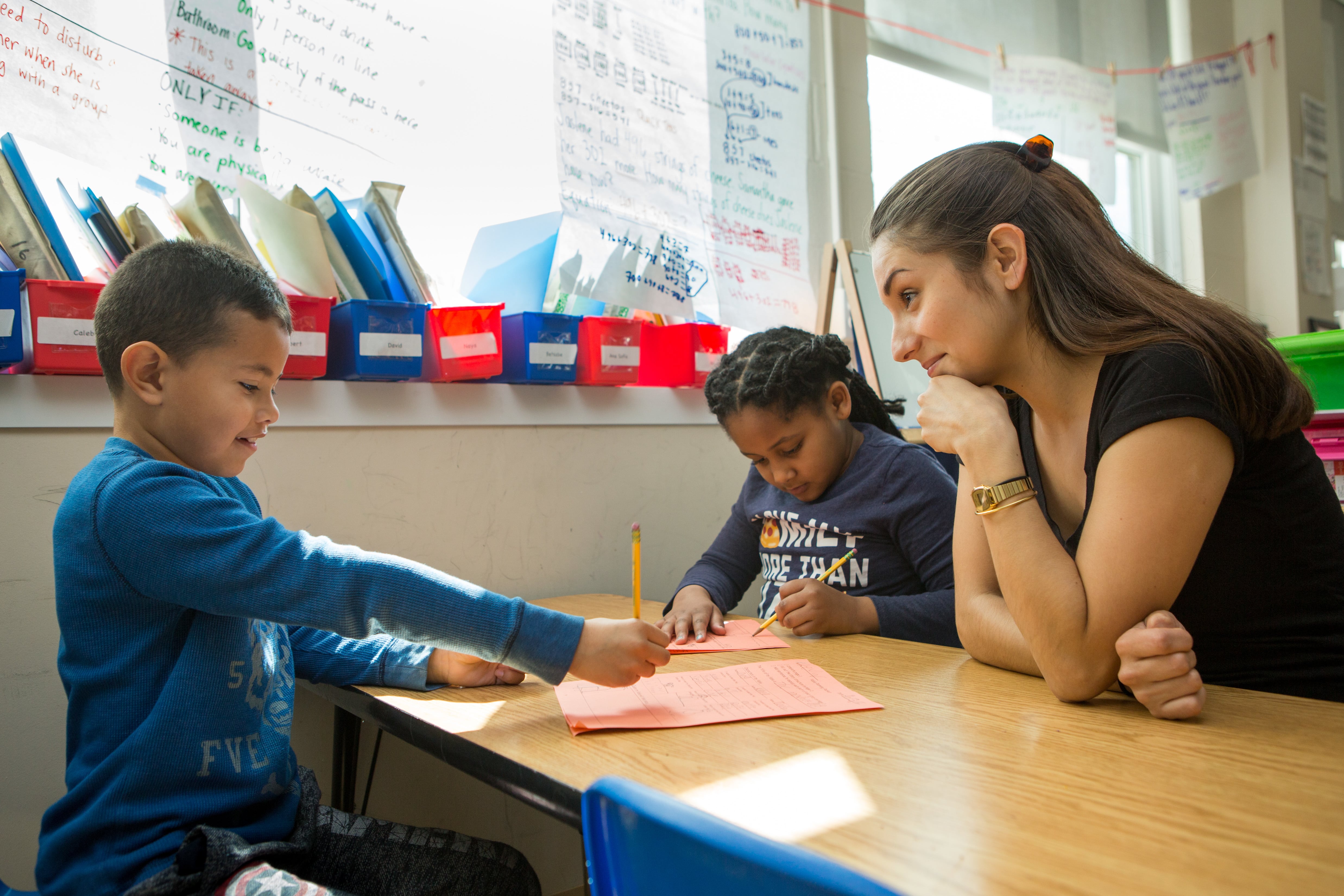Facing a sharp drop in applications, Teach For America is expecting its smallest crop of first-year teachers in at least 15 years, new data from the organization shows.
The organization expects to place just under 2,000 teachers in schools across the country this coming fall. That’s just two-thirds of the number of first-year teachers TFA placed in schools in fall 2019, and just one-third of the number it sent into the field at its height in 2013.
The latest drops are a continuation of a years-long trend. Still, it’s a striking decline for an organization that’s played a prominent role in American debates about how to improve education and how to staff schools that often struggle to attract and retain teachers.
“It’s more than you would expect,” said Pam Grossman, the dean of the University of Pennsylvania’s Graduate School of Education, who has studied teacher preparation. “In a strong economy you would expect interest to decline, but that’s a big drop.”
Alongside declines in enrollment at traditional teacher prep programs and other nontraditional programs, it’s also more evidence that interest in becoming an educator in the U.S. has fallen.
Enrollment in all kinds of teacher preparation programs stood at a little more than half a million in the fall of 2018, the latest federal data show, down 18% from eight years earlier. More recent data from colleges that produce large numbers of teachers is mixed: Some traditional programs have seen enrollment increases more recently, while others have seen small dips.
“You have to put TFA in the broader picture of teacher ed programs,” said Grossman, whose university partners with TFA to provide their teachers with additional training. “I don’t think they’re alone in seeing drops. This is, in general, a trend that I’m very concerned about.”
COVID has added to the challenge of convincing prospective educators to take the plunge. TFA officials acknowledged that the pandemic has made recruitment tougher.
“People are feeling like with what they’re seeing in teaching, they’re not sure they can do it,” Tracy St. Dic, TFA’s senior vice president of recruitment, said of the organization’s teacher prospects. “They care about social impact, they care about social issues,” she said, “but they also really want to have the security, and the safety, and the stability.”
Coupled with changing working conditions is a competitive job market.
“There are a lot of jobs,” Grossman said. “Teaching has to compete with so many other professions that also require a bachelor’s degree or more, but pay much better than teaching.”
Other teacher residency and alternative teacher prep programs are experiencing similar challenges. TNTP, for example, which runs a teacher fellowship program in Baltimore, New Orleans, Indianapolis, and elsewhere, has received fewer applications than it typically would by this time of year. Similarly, applications to the Chicago Teacher Residency program are slightly down from last year, a spokesperson wrote in an email. (Both programs will continue to recruit throughout the spring.)
“We’re seeing more people withdraw because they are no longer interested in being a teacher,” Jacob Waters, a spokesperson for TNTP, wrote in an email. The organization is hearing “greater concerns about the teaching profession, burnout, pay.”
The Arkansas Teacher Corps, which places teachers in rural Arkansas schools with acute staffing needs, received only 55 applications this year, about a third of the number they received four years ago. Meanwhile, schools are asking the organization for even more teachers.
Typically, the organization can fulfill only about 15% of school staffing requests. “It’s just a bigger discrepancy now,” said John Hall, who oversees recruitment for the program.
The pandemic is still disrupting the mechanics of new teacher recruitment, too. TFA recruited teachers remotely last year, and this year it’s still a mix of virtual and in-person recruitment, which can make it harder to build relationships with student groups and professors who refer candidates, St. Dic said. Programs that TFA has historically drawn teachers from, like a partner AmeriCorps reading tutoring program, have also had a harder time recruiting young workers during the pandemic, narrowing the pipeline.
TFA also has its specific perception issues to overcome, including the longstanding critique that the organization often puts little-trained teachers in high-need classrooms who then exit education after a couple years. The organization has made changes to address that over the years, including recruiting a more diverse group of teachers and placing more teachers in rural schools.
New recruits say that’s been a topic of discussion. When 21-year-old Sarai Hertz-Velázquez attended a recent orientation, she was struck that a TFA leader spoke candidly about how the organization could improve. That was important to Hertz-Velázquez, who has thought critically about race and power dynamics in her work as a tutor and after-school program staffer.
“I don’t think anyone that I’ve spoken to has a savior mindset or thinks that they’re going to change the lives of every student they work with,” she said. “Part of that is because TFA makes it known that that’s not what people should come in expecting to do.”
Still, some aspiring educators remain wary of TFA’s history and its early reputation for recruiting many young white, Ivy League-educated graduates.
“I don’t think the current leadership of the current organization would ever say that they would want to see themselves as white saviors,” said Joshua Starr, who heads PDK International, a professional organization for educators. “I’m sure they actively work against that. It still may have that perception.”
And as many school systems look to diversify their teaching ranks and attract candidates who are graduates of their own schools, districts may be more inclined to spend money on a grow-your-own program rather than on a contract with TFA, Starr said.
“TFA doesn’t loom as large as it used to,” Starr said.
For its part, TFA has made a number of recruiting changes in recent years. The organization recently tripled the number of historically Black colleges with a TFA recruiter, and it hired a Native staffer this year to help recruit aspiring Native teachers, St. Dic said.
TFA is trying other strategies, including new financial incentives. This year, the organization is offering every first-year teacher at least $5,000 to help pay for teacher certification and moving costs. Incoming teachers who qualified for Pell Grants or who have Deferred Action for Childhood Arrivals status will receive $10,000.
TFA has also recruited several hundred new teachers from the paid virtual tutoring program it launched during the pandemic. “What we believe is, when you meet students and you see what they’re capable of, and you see the impact you can have, it’s going to be hard to turn away from that,” St. Dic said.
Twenty-two-year-old Grant Jamison, for example, is joining TFA in the Cleveland area after working as a virtual tutor. He had already planned to join the corps, but after he worked with second-graders on their reading skills, he decided to seek an elementary school position. The experience of helping students learn to distinguish between the ‘B’ and ‘D’ sounds that had tripped them up stuck with him.
“It really flipped my idea of what it would actually be like teaching elementary school kids,” he said. Tutoring “definitely gave me a taste of teaching.”
And for some, meeting the needs the pandemic created or exacerbated in schools is part of the draw.
Patricia Garcia, 37, will be teaching through TFA in Texas’ Rio Grande Valley this fall after making a career change. She was a lab assistant at a technical college before the pandemic, but decided to take the leap into teaching after she enjoyed working with migrant high school students who’d fallen behind in their studies.
She knows she’ll be setting an example for students who grew up in the same community as her — “They’ll see me in the classroom teaching, and they’ll think ‘Hey, I could become a teacher, too,’” she said — and she’ll be stepping into the classroom when educators are in high demand.
“You hear stories in the news about the shortages and how people are resigning,” she said. “Right now, students need somebody to be there.”
Kalyn Belsha is a national reporter based in Chicago. Contact her at kbelsha@chalkbeat.org.





